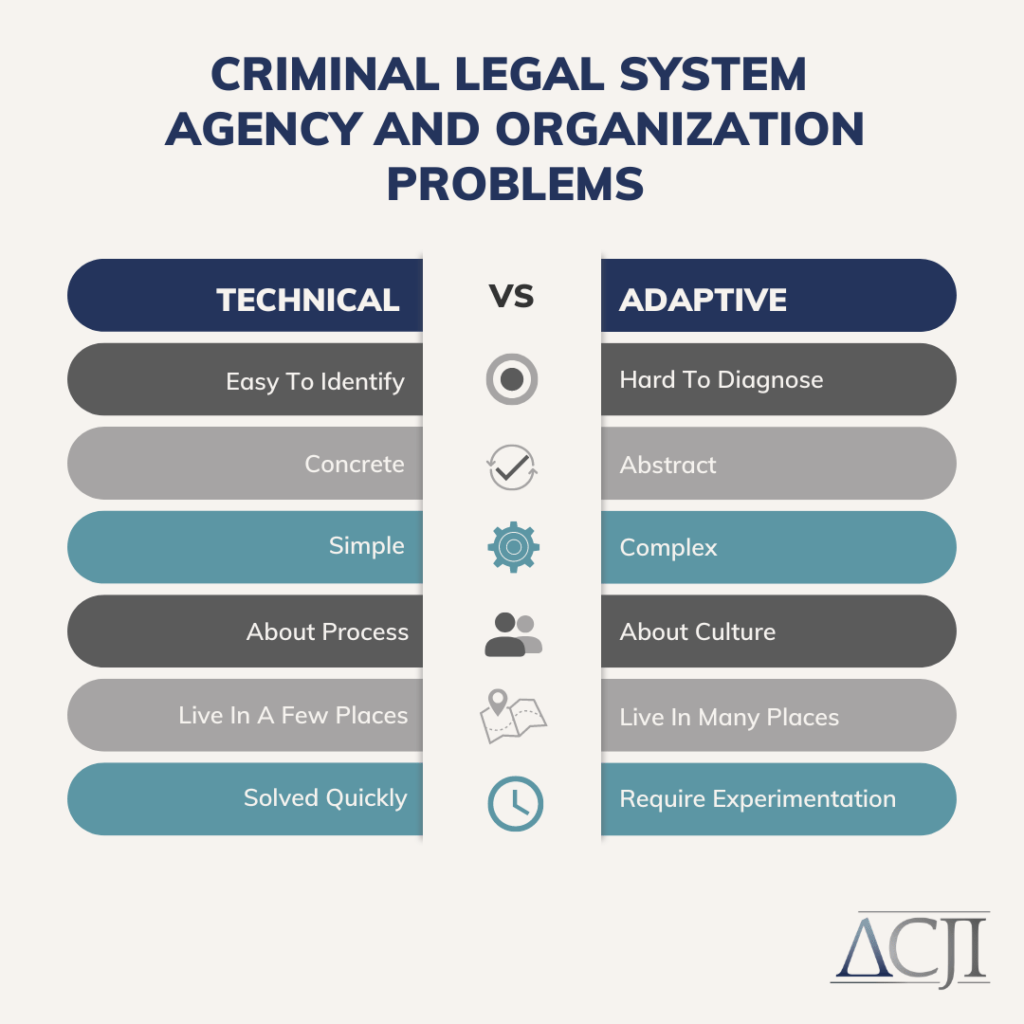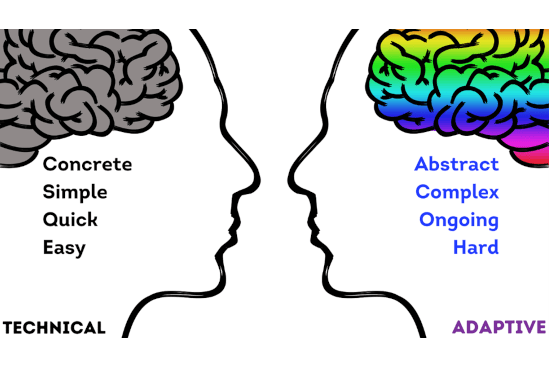Implementation Leadership Principle 4: Adapt Or Die
October 6, 2022 – This article is one in a series of articles about ACJI’s 10 Essential Principles of Implementation Leadership. If you’re new here, take a look at our first article in the series on principle 1 to start.
Many change initiatives in the criminal legal system die on the vine. Why? Because leaders create new problems by only addressing surface-level symptoms of a bigger problem or by applying the wrong solution altogether. To ensure your change initiative doesn’t get further eclipsed by poor problem diagnosis and solving, learn the difference between technical and adaptive problems and solutions.
Technical Problems vs Adaptive Problems
Technical problems are easy to identify, live in only a few places in an organization, and can often be solved quickly. They are clear-cut problems that require clear-cut solutions.
For example, let’s say a probation agency lacks a budget for a sanctions/incentives program but is otherwise ready and able to implement those sanctions and incentives. The lack of money is a clear-cut technical problem.
But what if the underlying attitudes, mindset, and culture are inhospitable to using incentives for clients? If that’s true, will a manager allocating a budget to incentives solve the problem or will they aggravate staff members with negative attitudes? That underlying mindset issue is an adaptive problem that a technical solution, like a budget, cannot solve.
Adaptive problems do not have a simple root cause. These problems can live in many places throughout an organization and are often problems of the collective mindset. Adaptive problems are challenging to identify and thus easy to deny. Solutions to adaptive problems require experimentation outside organizational norms and time to implement and perfect.

To the untrained eye, adaptive problems are hard to see. At ACJI, we develop experienced and emerging agency leaders to recognize the symptoms of an adaptive problem so that they are not mistaken for technical problems – a common occurrence.
This is important because when you solve adaptive problems with technical solutions you can create problem mutation which can be even tougher than the original problem to solve.
Adaptive Problem Example: Motivational Interviewing Resistance
Here’s a common example of a misdiagnosed adaptive problem. Let’s say staff at a local probation department are resistant to a new initiative to adopt Motivational Interviewing in their work with clients. Staff members say the new effort will take too much time and requires work they don’t know how to do. Technical solutions include hiring a new staff member to take on the extra work and providing training and coaching to teach the new skills.
Problem is…when these technical efforts are done and paid for, those same staff members still resist the initiative.
Time and money were spent yet the agency isn’t any closer to implementing that initiative. Now, staff members have been divided into groups, those who embrace motivational interviewing and are engaged in the process and those who resist the effort and say it’s “too soft” or “too clinical.”
The problem mutated into something larger because only a technical solution was applied to an adaptive problem.
A change leader who knows how to recognize adaptive problems would have seen the staff members’ resistance for what it is: Those who feel mastery over their current work often feel threatened by a new way of doing business.

About That Problem Mutation…
Problem mutation is the phenomenon that occurs when new, inorganic problems arise because leaders misapplied technical solutions to problems that are not technical. Technical solutions, when applied to adaptive problems, create more adaptive problems.
Technical solutions, when applied to adaptive problems, create more adaptive problems.
When you apply a technical solution to an adaptive problem, it further aggravates and escalates pre-existing negative attitudes about the change.
Policies, procedures, and performance expectations are well within the norm of public sector justice agency operations. However, it is rare that a new policy, procedure, or set of rules (technical solution) changes a person’s or a group’s pre-existing mindset against the change (adaptive problem).
If you are a criminal legal system leader, be sure to read our next article on Principle 5: Fail Forward, Fail Often. You can also learn more about the 10 Essential Principles of Implementation Leadership in ACJI’s upcoming Academy where we talk about all 10 of the principles in much more depth.





